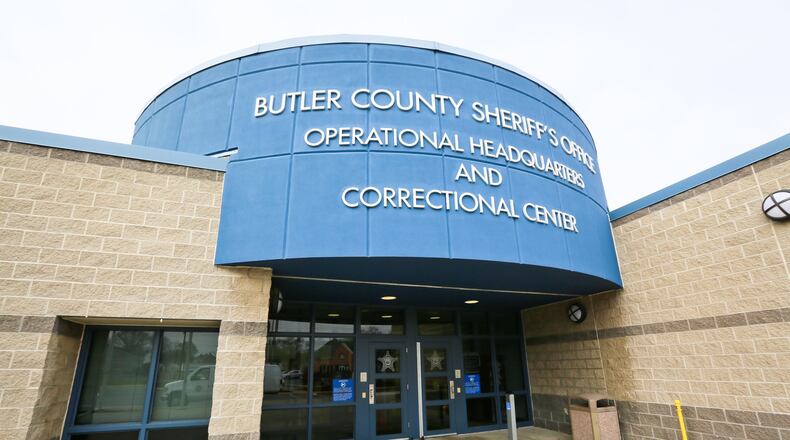RELATED: New Ohio prison law could cost Butler County $4 million
Butler County Administrator Charlie Young said it is very difficult to calculate what the ultimate price tag will be.
“We don’t have good statistics. We never had a reason before to track things this way,” Young said. “So it’s really hard to say what it will be.”
The commissioners’ office, sheriff’s office and courts have been working on a plan to deal with the influx of offenders — 170 to 200 — who would normally be housed on the state’s dime in prison. The state is offering some funding to offset the cost, but the county has held off on applying for the grants until now.
Had the county applied for the money when it was made available after the law passed last summer, they would have had to start keeping offenders here at that juncture. They didn’t yet have a plan in place and the money isn’t nearly enough to foot the entire bill, according to Young.
“The only reason we’re going after the money now, if we had gone after the money before we immediately had to start keeping these prisoners locally,” Young said. “Since that money paid for less than half the cost to keeping them here we didn’t see where it made any sense.”
As part of the state grant application process the commissioners, sheriff and courts needed to sign a memorandum of understanding (MOU) about the proposed program, which the commissioners finalized Monday. It spells out offenders will either be on electronic monitoring — a program not previously used in the county — or housed in jail. While at the jail offenders will receive all or a combination of services — expanded programs supported by the state grant — designed to help them overcome barriers such as mental health issues, substance abuse, lack of education and a host of others.
Court Administrator Wayne Gilkison said offenders on monitoring will also have access to treatment.
“If they are on electronic monitoring and the court allows it, we can get them programming in the community, if they are drug addicted or if they need mental health counseling or if they need anger management,” he said. “Whatever counseling they need, they would be allowed most of the time, to leave their house and get that wherever.”
MORE: Butler County sheriff advocates ankle monitoring as jail alternative
Katrina Wilson, coordinator for Butler-Warren Reentry Coalition, previously told the Journal-News that a program like this is exactly what is needed.
“Some believe introducing this type of program will permit violent offenders to ‘fall through the cracks’ and land back in our community. I don’t believe by implementing this program makes our communities less safe. In fact, I believe just the opposite,” Wilson said. “If we do not find a fix to the problem of over-committing low level, non-violent offenders, we will not have room in our jails and prisons for violent offenders who pose real threats to society.”
The MOU also stipulates no more than half of the state money — that was a state stipulation — can be used on boarding these offenders in the jail and the daily rate for housing these offenders will be $72.
Butler County Sheriff’s Chief Tony Dwyer said until the program is actually implemented July 1 they cannot know for sure what the impact will be on the jail.
“I have no idea how to know, I can get close, but I can’t definitively say how many prisoners are going to get sentenced to F-5s to be held here,” he said. “We have some ideas that it could be a pretty significant impact, so we are looking at the electronic monitoring… it’s a work in progress.”
The main jail has a capacity of 848 inmates but the sheriff also houses overflow offenders at the Resolutions facility — it holds about 170 offenders — on Second Street and he is considering reopening the Court Street jail that can handle 150 inmates. Dwyer said the jail population is near 1,000 inmates.
The common pleas judges will have sole discretion over who goes to jail and who can be managed with an ankle monitor. Gilkison said some offenders on ankle monitoring won’t be allowed out of their homes except for court dates, court ordered programming and doctor’s appointments, others may have more freedom. Typical felony five offenses are: felony non support of dependents; theft; possession of drugs; breaking and entering and receiving stolen property.
“The court is still going to look at every case defendant by defendant, upon whether or not we think that the probation department has resources that can both promote public safety and rehabilitate the offender, on how they sentence people,” Gilkison said.
Butler County Commissioner T.C. Rogers said when he got on the board a little over five years ago he was asked what was the first thing he was going to do. He said jokingly he was going to build a wall around Butler County to keep Columbus and Washington D.C. from interfering in county affairs with unfunded or under-funded mandates like this.
“We’re always fighting that they are going to take our efforts and take the money from us,” he said. “Well lo and behold that’s what’s happened time and time again and this last thing with felony fives is just another example, to balance their budget they shove it down to the local counties.”
About the Author
